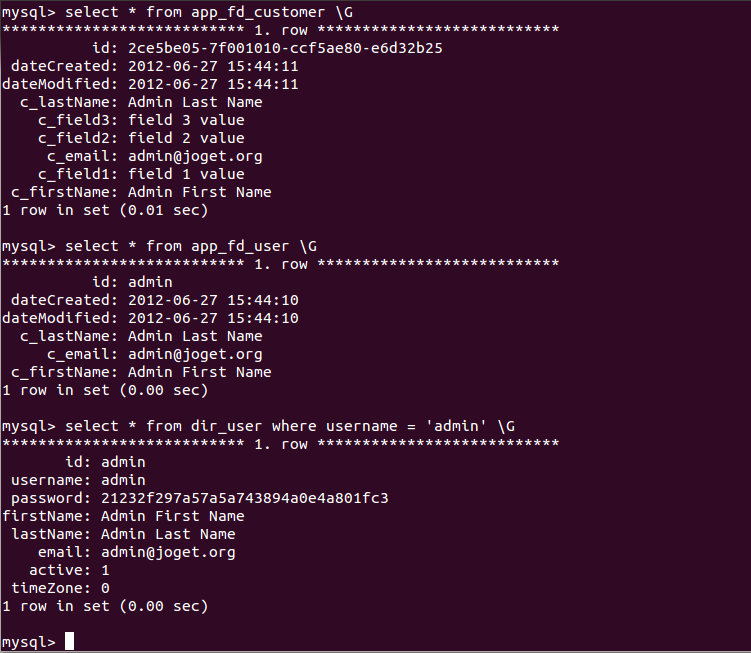You may want to store certain fields from your form to other tables with the use of the Beanshell Form Binder. Figure 1 shows an example of a form where the first 3 fields are to be stored in another data source in addition to the original form data table.
Figure1: Form with Field to Store
Then, click on the form "Properties" tab and navigates to "Advanced" page. Choose "Bean Shell Form Binder" as Store Binder.
Figure 2: Choose Bean Shell Form Binder as the Store Binder
Configure Bean Shell Form Binder with your own coding to store the fields as intended, as shown in the figure below.
Code used in this example:
import java.sql.Connection;
import java.sql.PreparedStatement;
import java.sql.ResultSet;
import java.sql.SQLException;
import javax.sql.DataSource;
import org.joget.apps.app.model.AppDefinition;
import org.joget.apps.app.service.AppService;
import org.joget.apps.app.service.AppUtil;
import org.joget.apps.form.model.Element;
import org.joget.apps.form.model.FormData;
import org.joget.apps.form.model.FormRow;
import org.joget.apps.form.model.FormRowSet;
import org.joget.apps.form.model.FormStoreBinder;
import org.joget.apps.form.service.FormUtil;
import org.joget.plugin.base.PluginManager;
import org.joget.commons.util.LogUtil;
public FormRowSet storeData(Element element, FormRowSet rows, FormData formData) {
//check for empty data
if (rows == null || rows.isEmpty()) {
return rows;
}
normalStoring(element, rows, formData);
//store only needed field by create new Form Row Set
FormRow originalRow = rows.get(0);
FormRowSet newRows = new FormRowSet();
FormRow newRow = new FormRow();
newRow.put("firstName", originalRow.getProperty("firstName"));
newRow.put("lastName", originalRow.getProperty("lastName"));
newRow.put("email", originalRow.getProperty("email"));
newRows.add(newRow);
String id = "#currentUser.username#";
//store
storeToOtherFormDataTable(element, newRows, formData, id);
storeUsingJDBC(element, newRows, formData, id);
return rows;
}
//this function will reuse workflow form binder to store data
public void normalStoring(Element element, FormRowSet rows, FormData formData) {
PluginManager pluginManager = (PluginManager) AppUtil.getApplicationContext().getBean("pluginManager");
FormStoreBinder binder = (FormStoreBinder) pluginManager.getPlugin("org.joget.apps.form.lib.WorkflowFormBinder");
binder.store(element, rows, formData);
}
//this function will store rows data to a form's data table
public void storeToOtherFormDataTable(Element element, FormRowSet rows, FormData formData, String id) {
AppService appService = (AppService) AppUtil.getApplicationContext().getBean("appService");
String formId = "user"; // the table of database is configured in the form with id "user"
AppDefinition appDef = AppUtil.getCurrentAppDefinition();
appService.storeFormData(appDef.getId(), appDef.getVersion().toString(), formId, rows, id);
}
//this function will store rows data to external source using JDBC
public void storeUsingJDBC(Element element, FormRowSet rows, FormData formData, String id) {
Connection con = null;
try {
// retrieve connection from the default datasource
DataSource ds = (DataSource)AppUtil.getApplicationContext().getBean("setupDataSource");
con = ds.getConnection();
if (!con.isClosed()) {
//manually handle insert and update by checking the data is exist or not
String selectQuery = "SELECT username FROM dir_user WHERE username=?";
PreparedStatement stmt = con.prepareStatement(selectQuery);
stmt.setString(1, id);
ResultSet rs = stmt.executeQuery();
Boolean isExist = false;
if (rs.next()) {
isExist = true;
}
FormRow row = rows.get(0);
if (isExist) {
String updateQuery = "UPDATE dir_user SET firstName = ?, lastName = ?, email = ? WHERE username = ?";
PreparedStatement ustmt = con.prepareStatement(updateQuery);
ustmt.setString(1, row.getProperty("firstName"));
ustmt.setString(2, row.getProperty("lastName"));
ustmt.setString(3, row.getProperty("email"));
ustmt.setString(4, id);
ustmt.executeUpdate();
} else {
String insertQuery = "INSERT INTO dir_user (id, username, firstName, lastName, password, email) values (?, ?, ?, ?, 'md5(password)', ?)";
PreparedStatement istmt = con.prepareStatement(insertQuery);
istmt.setString(1, id);
istmt.setString(2, id);
istmt.setString(3, row.getProperty("firstName"));
istmt.setString(4, row.getProperty("lastName"));
istmt.setString(5, row.getProperty("email"));
istmt.executeUpdate();
}
}
} catch (Exception ex) {
LogUtil.error("Sample app - StoreToMultipleSource form", ex, "Error storing using jdbc");
} finally {
try {
if(con != null) {
con.close();
}
} catch(SQLException e) {}
}
}
//call storeData method with injected variables
return storeData(element, rows, formData);
Figure 3: Populate Bean Shell Form Binder with the Necessary Codes
If the coding is properly written and tested, you will get this result:
Figure 4: Fill and Submit Form for Testing
Check the data in the database.
Figure 5: Data Stored Correctly in the Tables




